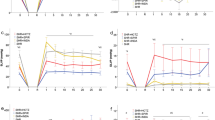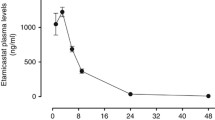Summary
We have studied the effects of triiodothyronine (T3) on heart function,on the myocardial oxidative pentose phosphate pathway, and on heart weight in spontaneously hypertensive (SHR) rats. Another aim was to examine whether these T3-effects may be reversible. T3 was administered daily (0.2 mg/kg s. c.) for 14 days. Compared to the untreated SHR controls, T3 induced an increase in heart rate (beast/min) from 357±10 (n=17) to 553±10 (n=17), in the pressure-rate-product (mm Hg/min) from 78400±4500 (n=15) to 113700±4800 (n=15), and in the heart weight/body weight ratio (mg/g) from 4.2±0.2 (n=20) to 5.8±0.2 (n=19). The activity of myocardial glucose-6-phosphate dehydrogenase, the first and rate-limiting enzyme of the oxidative pentose phosphate pathway (units/g protein), was clevated from 4.2±0.2 (n=9) to 7.0±0.6 (n=9) after 14 days of T3-treatment while the activity of 6-phosphogluconate dehydrogenase, one of the following enzymes in the pathway, was not altered appreciably. These changes returned to the respective control values when T3-treatment was discontinued for 14 days. Our results demonstrate that T3 had a positive chronotropic effect and induced an additional heart enlargement in an animal model with already established cardiac hyperfunction and hypertrophy. The effects on heart function and weight, which were fully reversible, were not as pronounced as in normal Sprague-Dawley rats.
Similar content being viewed by others
References
Bishop SP, Oparil S, Reynolds RH, Drummond JL (1979) Regional myocyte size in normotensive and spontaneously hypertensive rats. Hypertension 1:378–383
Dunn OJ (1964) Multiple comparisons using rank sums. Technometrics 6:241–252
Engelmann GL, Vitullo JC, Gerrity RG (1987) Morphometric analysis of cardiac hypertrophy during development, maturation, and senescence in spontaneously hypertensive rats. Circ Res 60:487–494
Folkow B, Hallbäck M, Lundgren Y, Weiss L (1970) Background of increased flow resistance and vascular reactivity in spontaneously hypertensive rats. Acta Physiol Scand 80:93–106
Frohlich ED (1986) Is the spontaneously hypertensive rat a model for human hypertension? J Hypertension 4 (Suppl 3):S15-S19
Gerdes AM, Moore JA, Bishop SP (1985) Failure of propranolol to prevent chronic hyperthyroid induced cardiac hypertrophy and multifocal cellular necrosis in the rat. Can J Cardiol 1:340–345
Gerdes AM, Moore JA, Hines JM (1987) Regional changes in myocyte size and number in propranolol-treated hyperthyroid rats. Lab Invest 57:798–813
Glock GE, McLean P (1953) Further studies on the properties and assay of glucose-6-phosphate dehydrogenase and 6-phosphogluconate dehydrogenase of rat liver. Biochem J 55:400–408
Glock GE, McLean P (1954) Levels of enzymes of the direct oxidative pathway of carbohydrate metabolism in mammalian tissues and tumours. Biochem J 56:171–175
Gray SD (1984) Pressure profiles in neonatal spontaneously hypertensive rats. Biol Neonate 45:25–32
Grossman W (1980) Cardiac hypertrophy: Useful adaptation or pathologic process? Am J Med 69:576–584
Limas C, Limas CJ (1987) Influence of thyroid status on intracellular distribution of cardiac adrenoceptors. Circ Res 61:824–828
Lortet S, Zimmer H-G, Rossi A (1989) Inotropic response of the rat heart during development and regression of triiodothyronine-induced hypertrophy. J Cardiovasc Pharmacol 14:707–712
Osler W (1982) The principles and practice of medicine. D Appelton and Company, New York, pp 712–714
Pelliccia A, Maron BJ, Spataro A, Proschan MA, Spirito P (1991) The upper limit of physiologic cardiac hypertrophy in highly trained elite athletes. New Engl J Med 324:295–301
Rioux F, Berkowitz BA (1977) Role of the thyroid gland in the development and maintenance of spontaneous hypertension in rats. Circ Res 40:306–312
Robinson HW, Hodgen CG (1940) The biuret reaction in the determination of serum proteins. J Biol Chem 135:727–731
Rodgers RL, McNeill JH (1986) Antihypertensive effect of thyroidectomy in SHR: associated changes in heart performance. Am J Physiol 350:H600-H605
Rosner B (1990) Fundamentals of biostatistics. PWS-Kent Publishing Company, Boston
Rupp H, Jacob R (1982) Response of blood pressure and cardiac myosin polymorphism to swimming training in the spontaneously hypertensive rat. Can J Physiol Pharmacol 60:1098–1103
Schunkert H, Jahn L, Izumo S, Apstein CCS, Lorell BH (1991) Localization and regulation of c-fos and c-jun protooncogene induction by systolic wall stress in normal and hypertrophied rat hearts. Proc Natl Acad Sci USA 88:11480–11484
Seymour A-ML, Eldar H, Radda GK (1990) Hyperthyroidism results in increased glycolytic capacity in the rat heart: A31P-NMR study. Biochim Biophys Acta 1055:107–116
Spech MM, Ferrario CM, Tarazi RC (1980) Cardiac pumping ability following reversal of hypertrophy and hypertension in spontaneously hypertensive rats. Hypertension 2:75–82
Trippodo NC, Frohlich ED (1981) Similarities of genetic (spontaneous) hypertension. Man and rat. Circ Res 48:309–319
Tsai JS, Chen A (1978) Effect of L-triiodothyronine on (−)3H-dihydroalprenolol binding and cyclic AMP response to (−)adrenaline in cultured heart cells. Nature 275:138–140
Van Liere EJ, Sizemore DA, Hunnell J (1969) Size of cardiac ventricles in experimental hyperthyroidism in the rat. Proc Soc Exp Biol Med 132:663–665
Williams LT, Lefkowitz RJ, Watanabe AM, Hathaway DR, Besch HR (1977) Thyroid hormone regulation of β-adrenergic receptor number. J Biol Chem 252:2787–2789
Zierhut W, Zimmer H-G (1989) Triiodothyronine-induced hemodynamic and metabolic changes: effects of α- and α-adrenergic blockade. Basic Res Cardiol 84:359–370
Zierhut W, Zimmer H-G (1989) Differential effects of triiodothyronine on rat left and right ventricular function and the influence of metoprolol. J Mol Cell Cardiol 21:617–624
Zimmer H-G (1983) Measurement of left ventricular hemodynamic parameters in closed-chest rats under control and various pathophysiologic conditions. Basic Res Cardiol 78:77–84
Zimmer H-G, Ibel H, Gerlach E (1980) Significance of the hexose monophosphate shunt in experimentally induced cardiac hypertrophy. Basic Res Cardiol 75:207–213
Zimmer H-G, Peffer H (1986) Metabolic aspects of the development of experimental cardiac hypertrophy. Basic Res Cardiol 81 (Suppl 1):127–137
Zimmer H-G, Zierhut W, Marschner G (1987) Combination of ribose with calcium antagonist and β-blocker treatment in closed-chest rats. J Mol Cell Cardiol 19:635–639
Zimmer H-G, Ibel H, Suchner U (1990) β-Adrenergic agonists stimulate the oxidative pentose phosphate pathway in the rat heart. Circ Res 67:1525–1534
Author information
Authors and Affiliations
Rights and permissions
About this article
Cite this article
Heckmann, M., Zimmer, H.G. Effects of triiodothyronine in spontaneously hypertensive rats. Studies on cardiac metabolism, function, and heart weight. Basic Res Cardiol 87, 333–343 (1992). https://doi.org/10.1007/BF00796519
Received:
Accepted:
Issue Date:
DOI: https://doi.org/10.1007/BF00796519




